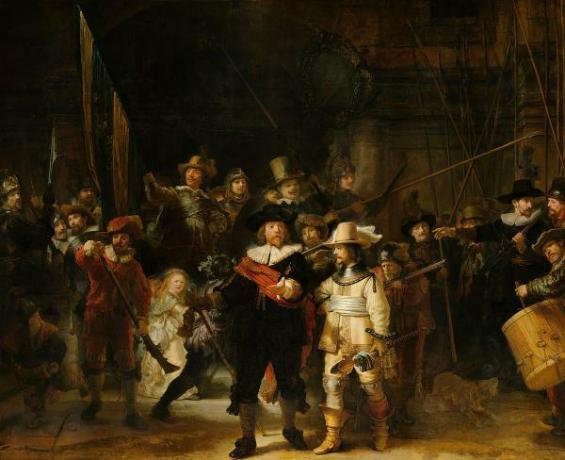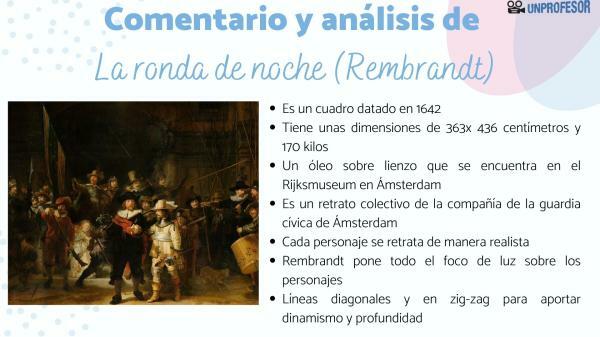REMBRANDT's night watch

the night watch It is one of the most outstanding works, an authentic masterpiece, of Rembrandt (1606-1669), one of the great universal geniuses of painting, in addition to being the maximum exponent of Baroque. One of the great figures of the Dutch Baroque School that gives us a frequent picture in Holland, but not so much in the rest de Europa: a collective and realistic portrait in which an attempt is made to show each of the protagonists with their features individual.
In this lesson from a PROFESSOR we offer you a commentary and analysis ofthe night watch by Rembrandt, a special work that demonstrates Rembrandt's spirit of freedom and innovation.
Index
- The night watch: analysis of the work
- The Night Watch: Comment
- Meaning of The Night Watch
The night watch: analysis of the work.
the night watch it is a dated painting in 1642 and that it has dimensions of 363 x 436 centimeters, with a weight of about 170 kilos without its frame. An oil on canvas found in the Rijksmuseum in Amsterdam and is currently being restored.
It's a collective portrait of the company of the amsterdam civic guard, the company of Captain Frans Baning Cocq, a character who is located in the center of the scene. A type of painting that is highly sought after in the Netherlands and that used to be financed by all those people who want to appear in the painting. Each character is realistically portrayed.
Issue
Although this type of painting was not new, it did it is innovative dealing with a common theme such as an urban and bourgeois group portrait in the style of paintings from the European pictorial tradition, that is, with the grandiose and heroic air that was given to paintings of monarchs or nobles. A traditional Catholic and Mediterranean style that the Dutch had put aside and that Rembrandt recovers for a more everyday theme.
Description
The civic guard appears at the doors of a palace with columns. The guards are located at the foot of a staircase, just before the formation of the group and their preparation to go out to do the rounds and place themselves under the orders of their boss. The scene is charged with a certain tension and drama, something rare in Dutch painting.
The company is preparing to form and go out to keep an eye on the order in the city. In addition to the arquebusiers, three running children and a dog also appear in the painting.
Composition
The composition of the frame is dynamic and quite complex. They are not isolated and all integrate a joint action. Each of the characters are dressed in elegant and ornate clothing. Although at first glance it seems to us that the work has a certain disorder, the composition is very careful and studied. Thus, Rembrandt gives more importance to action than to portraits, trying to capture the moment in a spontaneous way. For this, the painter establishes a series of diagonal and zigzag lines as a way of providing dynamism and depth.
The characters are distributed in four planes deep The captain and the lieutenant are located in the center, while the rest of the men are organized in triangular groups. Some characters are visible, while others remain in the shadows, showing only their heads.
Light
Rembrandt puts all the spotlight on the characters that he has chosen, leaving the rest of the scene in a certain gloom. Light thus becomes a tool to balance the composition and provide an epic and lyrical air to the entire scene.
Color
Although color is not the protagonist of the work, it is very rich and with a great variety of shades and contrasts. The background of the painting is filled with gray and brown colors, although there are also bright colors with which objects such as the lieutenant's and captain's suits stand out. Golden and warm tones predominate in the painting, applying these with wide and pasty brushstrokes, also combining with other smaller and finer ones.

The night watch: commentary.
Let's deepen our commentary the night watch talking about its historical context and knowing, better, the characters that are part of the painting.
History
In the seventeenth century Holland had reached a prosperity and remarkable wealth, in addition to becoming independent. In this situation and as a way of celebrating their economic and political boom, the Calvinist bourgeois became clients of Dutch artists. Some works that became part of the decoration of bourgeois homes. Some commissioned works that, in this case, came from the Arquebusiers Corporation of Amsterdam to decorate the 'Great Hall' of the militia headquarters. The space for which it was intended is the reason for the large dimensions of the work, since it It is usual that they were smaller as they were designed for living rooms or rooms in homes bourgeois.
In addition to the captain and the lieutenant, 18 more members appear in the painting. They all paid about 100 guilders each to appear in the painting, the officers' fee being somewhat higher. Rembrant collected about 1,600 guilders, a considerable figure for the time.
The painting belongs to the Amsterdam City Council, since the arquebusiers were an institution dependent on it. The order had to be prepared for the inauguration banquet of the company's headquarters, being one of the various events organized to commemorate the visit of Queen Marie de' Medici to Amsterdam in 1638. She arrived in exile by order of hers, her son, Louis XIII.
To the not seeing well defined physical features, company members delayed payment. Be that as it may, the painting had an impact and this type of painting with commissioned portraits became a trend.
Characters of the night watch by Rembrandt
Among the main characters that appear reflected in the night watch they find each other:
- The girl is supposed to be the painter's wife, Saskia van Uylenburgh (1612-1642), muse and regular model in his paintings. She died the year he made the painting. Her death led Rembrandt to suffer a deep depression.
- Captain Frans Banninck Cocq or Banning Coq (1605–1655). He is the captain of the company and is located in the center of the painting and marks the axes that order the scene.
- Lieutenant Willem van Ruytenburch or van Ruytenburgh (1600-1657). This character was short and the painter managed to highlight him by using vibrant tones in his clothes.
Other characters that appear in the painting are the fifteen other members of the militia: Reinier Engelen, Jan Pietersen Bronchorst, Elbert Willemsen, Herman Jacobsen Wormskerck, Jan van der Heede, Jan Visscher Cornelissen, Claes van Cruijsbergen, Jan Ockersen, Jan Andriaensen Keijser, Walich Schellingwou, Jan Claesen Leijdeckers, Barent Harmansen Bolhamer, Rombout Kemp, Paulus Schoonhoven and Jacob Jorisz.
The painting suffered a cut on its left side and the three characters in the scene were eliminated. The appearance and all the original characters are known thanks to copies made before 1715.
the night watch is one of the Rembrandt's most admired works, as well as representing the best of the Dutch Golden Age.

Meaning of The Night Watch.
Rembrandt gets turn a daily activity such as a guard round into an event. Thus, the painter combines the group portrait with a historical recreation and manages to revolutionize the pictorial scene of the moment.
The composition is novel and the technique surprising For its quality. Rembrandt breaks with tradition and conventions by placing the sitters based on the plasticity of the painting and not by hierarchy. Something that annoyed those portrayed, since their rank was not distinguished. A modern approach that demonstrated the freedom of the painter
The painting also contains a certain symbolism, because includes a girl situated out of the twilights who acts as a standard bearer. A figure that it is thought may not be a girl but a companion of the company represented in a small size because it is a secondary character.
Is considered one of Rembrandt's most accomplished works and from the Dutch school and is curious that its name, The night round, dates from the 19th century and is a failed name, since this type of round was done during the day. The painting darkened due to the oxidation of the varnish and the accumulated dirt, giving the sensation of being in front of a night scene.
When it was restored in 1947, it was possible to verify that it really it was a daytime scene, keeping the name of The Night Watch. Its original title was The Military Company of Captain Frans Banning Cocq and Lieutenant Willen van Ruytenburg.
If you want to read more articles similar to The Night Watch: Commentary and Analysis, we recommend that you enter our category of History.
Bibliography
- ANGLE, Julio, et al. Rembrandt's Greatness and Misery. National magazine of education, 1950.
- CALVO MANUEL, Ana. Rembrandt. The painter's work. Ge-conservation, 2009, p. 211-213.
- DI LORETO, Juan Alberto. Rembrandt: aesthetics, subjection and corporality. Notebooks of the Center for Design and Communication Studies. Essays, 2020, no 78, p. 128-139.
- GARRIDO, Coke. Rembrandt experimental engraver and the society of his time. Publications Service, Complutense University, 1998.
- MOLYNEUX, John. Rembrandt and Revolution. Editorial The Old Mole, 2004.
- MULLER, Joseph-Emile.: Rembrandt, Provenza editions, Barcelona, 1968.
- RUSSO, Patricia; RUSSO, Alejo Lo. The night round Passion of crowds In II° INTERNATIONAL CONGRESS X° MEETING “ARMANDO CAPALBO” ON EXPERIENCES AND WRITINGS IN CONSUMER CULTURE. 2021.
- TASTE-BEJARANO, Andrés. Rembrandt on his four hundredth anniversary. Academic Record, 2007, vol. 40, not May, p. 23-27.
- TÜMPEL, Christian, et al. Rembrandt. TO. Michael, 1986.
- UBEDA DE LOS COBOS, A. Rembrandt's century. Spanish Art Archive, 1986, vol. 59, no. 234, p. 249.
- VAN DONGEN, Kees; LEFT, Miguel Ángel Hermida. Rembrandt. Nausica Edition, 2018.
- WESTENDORP GIROLDI, Connie Elisabeth, et al. The contemporary portrait and self-portrait in the footsteps of Dürer, Rembrandt and Goya: Picasso, Bacon, Warhol, Freud, Richter and Close in the public light; relationships, comparisons, analysis and criticism. Granada: University of Granada, 2012.
- WHITE, Christopher.: Rembrandt, Destination Editions, Barcelona, 1992.



